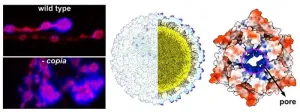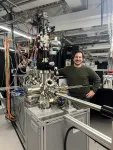(Press-News.org) Vision changes are an inevitable part of aging, but why are some more susceptible to age-related eye diseases and why do some individuals experience more severe decline than others? New research from The Jackson Laboratory (JAX) reveals that genetics play a key role in how the eye ages, with different genetic backgrounds influencing retinal aging in distinct ways.
The study, published in Molecular Neurodegeneration, examined age-related changes in genes and proteins of the retinas of nine strains of mice, mimicking the genetic variability found in humans. While all mice exhibited expected signs of aging, the severity and nature of these changes varied significantly between the nine strains.
A more accurate approach to model eye aging
Traditionally, studies of retinal aging and disease have relied on a single strain of genetically identical mice, limiting researchers’ ability to understand the role of genetic variation. “The challenge in studying age-related eye diseases is that aging is heterogeneous,” said Gareth Howell, professor and Diana Davis Spencer Foundation Chair for Glaucoma Research at JAX, who led the research. “Observing how aging occurs in one strain of mice might not be relevant to all mice – or humans. To overcome the limitations of previous studies, we wanted to know how genetic context drives aging of the retina.”
In his work, Howell and his team leveraged nine strains of mice with different genetic backgrounds designed to better reflect human variability, generating data on age-related genetic and molecular changes in young and old mice. With their dataset now publicly available, Howell and his team hope their findings will help other scientists studying aging and vision loss – work that may also improve the utility of the eye as a window to the brain to predict neurological decline.
Genetic and protein analyses predict eye diseases
One of the most significant discoveries in the study was the identification of two mouse strains that closely resemble human retinal diseases. By performing eye exams – like what a human would undergo at a routine optometrist appointment, the researchers found that the Watkins Star Line B (WSB) strain developed characteristics of age-related macular degeneration and retinitis pigmentosa, a rare inherited form of blindness, while the New Zealand Obese (NZO) strain, known for its severe obesity and diabetes, developed diabetic retinopathy. Furthermore, gene and protein analysis in both strains of mice predicted that they would develop common age-related eye diseases.
“It was promising to see that the molecular data we generated predicted specific retinal cell abnormalities in these two strains” said Olivia Marola, a JAX postdoctoral associate and co-first author of the new paper. “When we saw unique changes in NZO’s retinal ganglion cells at the molecular level, sure enough, we saw drastic functional changes in those cells.”
These models will allow researchers to study how these diseases progress and explore potential treatments, explained Michael MacLean, a postdoctoral associate and co-first author of the work.
It could also help other scientists choose which mouse models to use in their own aging-related work or carry out further studies to pinpoint individual genes that are associated with accelerated eye aging and eye disease such as cataracts, glaucoma, macular degeneration, and diabetic retinopathy.
Retina as biomarker for Alzheimer’s
Beyond vision research, this study could have broader implications for neurodegenerative diseases. Since the retina is a direct extension of the brain, understanding how it ages could provide clues about conditions like Alzheimer’s and other forms of dementia.
“The eye is a crucial organ, and this research fills an important gap in our understanding of aging,” said Howell. “But beyond that, the eye is a window into the brain. By understanding how the healthy eye ages, we may be able to work toward new ways of using the eyes to determine people’s risk of developing diseases like Alzheimer’s.”
END
New study uncovers how genes influence retinal aging and brain health
JAX researchers used mice with nine different genetic backgrounds to identify factors influencing eye aging, paving the way for eye-based diagnostics for neurodegenerative diseases
2025-02-18
ELSE PRESS RELEASES FROM THIS DATE:
‘False’ springs, long summers mean uncertainty for NY grape growers
2025-02-18
CORNELL UNIVERSITY MEDIA RELATIONS OFFICE
FOR RELEASE: Feb. 17, 2025
Kaitlyn Serrao
607-882-1140
kms465@cornell.edu
‘False’ springs, long summers mean uncertainty for NY grape growers
ITHACA, N.Y. – Warmer autumns and more “false” springs are disrupting the signals grapevines rely on to gain cold hardiness for the winter and blossom effectively in the spring, according to new research from Cornell University.
“In New York, we are right at the coldest ...
A treatment-resistant, severe type of asthma successfully modeled in mice
2025-02-18
A better understanding of inflammation and lung immunity over the past two decades has led to new, innovative treatments for asthma, including biologic therapies.
This is especially true for a subtype known as eosinophilic asthma—asthma that’s related to the recruitment and overactivation of white blood cells in the lungs called eosinophils.
However, a different type of asthma called neutrophilic asthma has fewer treatment options and doesn’t respond as well to first line asthma therapy.
As a result, people with this type of asthma, which ...
Cholesterol metabolism byproduct linked to Parkinson’s disease
2025-02-18
Researchers led by Zhentao Zhang at Wuhan University, China have discovered a cholesterol metabolite that plays a critical role in the development of Parkinson’s disease in mice. Published in the open-access journal PLOS Biology on February 18th, the study shows that this metabolite is responsible for the formation of Lewy bodies and the death of dopaminergic neurons in the brain—the two major hallmarks of Parkinson’s disease. Blocking its activity or preventing it from being made by the body could therefore be effective strategies for treating the disease.
Parkinson’s disease develops when the protein alpha-Syn forms clumps of tiny pathological fibers ...
The capsid of the virus-derived retrotransposon Copia, a parasitic genome element, mediates synaptic plasticity at the Drosophila neuromuscular junction
2025-02-18
In your coverage, please use this URL to provide access to the freely available paper in PLOS Biology: https://plos.io/42Ly2Pr
Article title: Capsid transfer of the retrotransposon Copia controls structural synaptic plasticity in Drosophila
Author countries: United States
Funding: This work was supported by NIH Grant R01NS112492 to TT. The funders had no role in study design, data collection and analysis, decision to publish, or preparation of the manuscript. END ...
Sweet molasses feed key to understanding grazing behavior in cattle
2025-02-18
Researchers tempted grazing cattle with sweet molasses feed to discover whether cows would roam far and wide to graze or stick close to the herd, water supplies and feed stations.
The findings by animal scientists at the University of California, Davis, and published in the journal Scientific Reports, offer a low-cost way for ranchers and others to identify the best cows for their landscapes to optimize grazing while meeting the nutritional needs of cattle.
This is the third in a series of papers about research seeking to better understand the grazing personalities of cattle. The first studies ...
Fabio Boschini, first INRS researcher to receive an Alfred P. Sloan Fellowship
2025-02-18
MONTRÉAL and VARENNES, QC, Feb. 18, 2025 /CNW/ - Professor Fabio Boschini is among the 126 recipients announced today by the Alfred P. Sloan Foundation in seven fields. Sloan Fellowships support outstanding early-career scientists who demonstrate creativity, ambition, and dedication to advance discovery. These rising stars of research come from American and Canadian schools and are definitely names to watch. Many Sloan Fellows have gone on to become Nobel prize winners.
INRS Professor Fabio Boschini has just received a prestigious ...
Biomedicine shows the way to future food crops
2025-02-18
University of Queensland researchers have for the first time introduced genetic material into plants via their roots, opening a potential pathway for rapid crop improvement.
Professor Bernard Carroll from UQ’s School of Chemistry and Molecular Biosciences said nanoparticle technology could help fine-tune plant genes to increase crop yield and improve food quality.
“Traditional plant breeding and genetic modification take many generations to produce a new crop variety, which is time-consuming and expensive,” Professor Carroll said.
“We have succeeded in having plant roots absorb a benign nanoparticle which ...
First 5 regions chosen to focus innovative effort on diagnosing, treating CKM syndrome
2025-02-18
DALLAS, Feb. 18, 2025 — Five regions in the U.S. have been selected to implement a new preventive health initiative to improve care for people with a cluster of chronic conditions known as cardiovascular-kidney-metabolic (CKM) syndrome. Through the initiative the American Heart Association, devoted to changing the future to a world of healthier lives for all, aims to increase awareness and screening for CKM syndrome and facilitate collaboration among health care professionals.
CKM syndrome is a clinical term that describes the combined health effects of heart disease, kidney disease, diabetes and obesity, which puts people at high risk for heart ...
Kahramanmaraş earthquake study showcases potential slip rate errors
2025-02-18
Accurate assessment of the land surface damage (such as small-scale fracturing and inelastic deformation) from two major earthquakes in 2023 can help scientists assess future earthquake hazards and therefore minimize risk to people and infrastructure. However, attaining precise extensive measurements in earthquake zones remains challenging.
The two earthquakes that struck on 6 February 2023 were devastating: they were of magnitude 7.8 and 7.6 and occurred in quick succession near the border between Syria and Turkey. They caused widespread infrastructure destruction and resulted in tens of thousands of deaths across multiple provinces.
Using ...
Abortion changes among residents of an abortion rights protective state
2025-02-18
About The Study: This cross-sectional study found a statistically significant increase in abortions for Colorado residents in association with the implementation of Texas SB8. This aligns with reports from area clinicians who experienced dramatic increases in patient demand after SB8, also reported by the media, resulting in delayed appointments for everyone.
Corresponding author: To contact the corresponding author, Kelly A. DeBie, J.D., email kelly.debie@colostate.edu.
To access the embargoed study: Visit our For ...
LAST 30 PRESS RELEASES:
Post-stroke injection protects the brain in preclinical study
Cardiovascular risk score predicts multiple eye diseases
Health: estimated one in ten British adults used or interested in GLP-1 medications for weight loss
Exercise to treat depression yields similar results to therapy
Whooping cough vaccination for pregnant women strengthens babies’ immune system
Dramatic decline in new cases of orphanhood in Uganda driven by HIV treatment and prevention programs
Stopping weight loss drugs linked to weight regain and reversal of heart health markers
Higher intake of food preservatives linked to increased cancer risk
Mass General Brigham–developed cholera vaccine completes phase 1 trial
First experimental validation of a “150-year-old chemical common sense” direct visualization of the molecular structural changes in the ultrafast anthracene [4+4] photocycloaddition reaction
Lack of support for people on weight loss drugs leaves them vulnerable to nutritional deficiencies, say experts
Dogs’ dinners can have greater climate impact than owners’
Are you ready to swap salmon for sprats and sardines?
1.6 million UK adults used weight loss drugs in past year
American College of Cardiology comments on new dietary guidelines for Americans
American Society of Gene & Cell Therapy and Orphan Therapeutics Accelerator partner to advance and commercialize promising rare disease treatments
One in 14 patients having day case surgery have new or worse chronic pain 3 months after their operation
New study highlights link between eviction rates and gun violence
Heatwaves heat up soil but not toxin levels in rice, study finds
Digital modeling reveals where construction carbon emissions really come from
Turning farm waste into water filters
New study shows how the spleen helps the immune system accept a transplant
New Mayo Clinic study advances personalized prostate cancer education with an EHR-integrated AI agent
Researchers identify novel therapeutic target to improve recovery after nerve injury
Microbes in breast milk help populate infant gut microbiomes
Reprogramming immunity to rewrite the story of Type 1 diabetes
New tool narrows the search for ideal material structures
Artificial saliva containing sugarcane protein helps protect the teeth of patients with head and neck cancer
Understanding the role of linear ubiquitination in T-tubule biogenesis
Researchers identify urban atmosphere as primary reservoir of microplastics
[Press-News.org] New study uncovers how genes influence retinal aging and brain healthJAX researchers used mice with nine different genetic backgrounds to identify factors influencing eye aging, paving the way for eye-based diagnostics for neurodegenerative diseases





